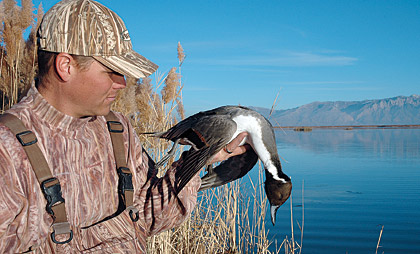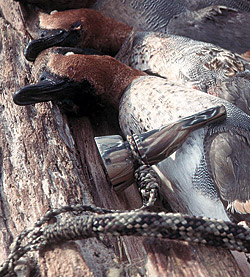October 22, 2010
By M.D. Johnson
When quack, quack, quack just won't do.
By M.D. Johnson
 Pintails call be fickle about calling, and they often ignore traditional quacks. However, making the clear trill of a bull sprig on a whistle can pull pintails into the decoys. |
"Wigeon! Don't move!"
Beside me, I could feel Julie, my wife and gunning partner, shiver. And despite a chill courtesy of the west wind blowing across Washington's Willapa Bay, I knew it wasn't from the cold.
Overhead, the high-pitched whoosh of pinions cutting the Pacific air mixed with the breathy whistles and peeps of a dozen or more drake baldpate. Looking out from under the bill of my cap, I registered a small group of birds, cupped and committed, descending into the decoys, while above them, another flock cut into what I assumed was going to be their final swing before they too committed.
Advertisement
To my right, Julie mimicked the "whoo-WHIT-whooo" of the drakes -- first with her natural voice, then switching to the whistle hanging around her neck.
"Whatever you're saying, sweetie," I thought to myself as my fingers tightened around the grip of my shotgun, "just keep it up."
Advertisement
Several splashes out front signaled touchdown for the leading edge of the flock. Risking a peek over the edge of the blind revealed the remaining birds on a final approach. Julie, now using only her natural voice, continued to whistle.
"Let's do this," I whispered. I didn't have to say it twice.
Quack, Quack
I like mallards. I'll be the first to agree few things look as nice as a big ol' duck strap heavy with greenheads. And on the table? Well, I'd just as soon slice into a marinated mallard breast quick-fried on the grill as I would dive into a deep-dish pizza.
However, there are ducks other than mallards. Yes, I know. To some, the statement is sacrilegious. And to others, even thinking such thoughts would not only get you thrown out of the duck club, but quite likely out of the state as a whole. Still, it's true: There are ducks other than mallards.
Not all ducks quack, but a good old-fashioned mallard hen highball or feeding chuckle will work on a variety of species. The drawing power of quacks is certainly one reason behind our reluctance to try different calls. However, for days when the sprig, wigeon or greenwings just don't seem to want to pay much attention to a traditional quack, quack, quack, doesn't it make sense to give them something else?
Simple Tools
Most duck vernacular fits into two basic categories of sounds: quacks and whistles. True, divers have growls and purrs, and drake grey ducks make a nasally "dink-dink-dink." Still, waterfowlers mimicking their quarry generally speak in terms of quack or whistle.
My first non-mallard call was an ordinary referee's whistle, although mine was a more hunter-friendly, olive drab-green color. Blown upside-down so as not to allow the pea inside to vibrate, the whistle didn't produce the typical trilling sound. Rather, it emitted a mellow, airy tone almost identical to a drake wigeon's voice. With subsequent calls, we simply split the piece, removed the pea and glued the halves back together.
Today, several companies make whistles or whistle-esque calls meant to mimic sprig, wigeon, green-winged teal, wood ducks and other ducks. Similar in design, one-piece so-called pintail whistles offer a lightweight, versatile call capable of reproducing not only the aforementioned species, but also the lisping "dweek" of a drake mallard, the high-pitched scream of a red-tailed hawk and a quail's familiar "bob-bow-WHITE!" Other models are a bit more futuristic in appearance, but all are quite adept at creating trills, peeps and whistles.
It's one thing to have the tools. However, it is often another to use them correctly. Fortunately, whistling is not nearly as complicated as is quacking. In fact, it's rather simple. All you need to know are the players and how they converse.
 Green-winged teal can be coaxed by a high-pitched cadence of peeps. |
Vocal Baldpate
Wigeon are very vocal ducks, both in the air and on the water. It is easy to imitate their simple two- or three-note whistling. Phonetically, the wigeon's call sounds like "woo-whIT-woo," with each sound or word being produced in a breathy, back-of-the-throat sort of way. The drake also makes a two-note whistle -- "whIT-woo."
In my time throughout the Pacific Flyway, I've come to the conclusion it is almost impossible to overcall wigeon. I seem to have better success with multiple callers, each mixing his or her own two- or three-note sequences together. The result is a lot of sound that carries well despite wind or distance.
Bell-Clear Pintails
Unlike the wigeon's breathy tones, the bull sprig's whistle is almost bell-like in its clarity, and pintails incorporate a rolling trill not heard in the baldpate. A dog whistle will work -- sometimes quite well. However, I've found sprig-specific calls seem to produce a clearer, truer tone.
Pintails are often fickle about decoys and calling. Combining the bull sprig's trill with a traditional jerk cord and two-dozen to three-dozen drake pintail decoys works well on shy, late-season birds. The combination is also effective on other pressured puddle duck species.
Peeping at Teal
I've only experimented with teal-specific call for the past couple seasons, but I am a believer. They don't work 100 percent of the time, but then again, few things work every time.
Green-winged teal are peepers. They make a high-pitched whistled "PEEP!" -- short in duration and high in volume. Phonetically, the cadence when calling greenwings is "peep! PEEP-peep! Peep."
For greenwings, I want a louder call with volume that is note-for-note as clear as proverbial crystal. As for timing, I tend to peep at greenwings as they swoop and swing the spread, using the short blasts more as a confidence call than an attractant.
Tough to Turn
I grew up northeast Ohio with an abundance of wood ducks. In my experience, 99.9998 percent of the wood duck population will ignore a wood duck call. However, I did on one occasion see a flock change course and return to a small, timbered pothole where my cousin, wood duck call in hand, had just called to them in their "peet-w-o-o-O-O-I-T" rising whistle.
Coincidence? Perhaps, but it was enough to convince me that on that one-in-a-million occasi
on, when a flying wood duck wants to listen, it will. Otherwise, I'm relatively sure they're deaf.
Loop on a Lanyard
Given the number of North American duck species that produce whistle-like sounds, isn't at least one loop on your call lanyard worthy of carrying a whistle? Even if you live to hunt greenheads, you never know when a bull sprig or handsome baldpate -- bonus ducks -- will wing over.
M.D. Johnson of Martelle, Iowa, whistles and quacks at ducks throughout North America.
